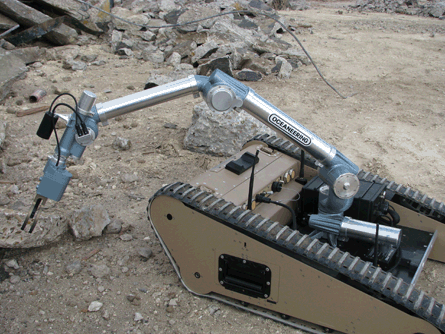Oceaneering Space Systems, a division of Oceaneering International, recently released a new robotic manipulator, the Terabot S, which it is displaying on a Mesa Technologies Matilda XL robot.
The electric manipulator, with five degrees of freedom, is controlled via what David Spangler, head of the company's Robotics and Automation division, says is "kind of like a Mini-Me," since it's essentially a smaller robotic arm.
Showcased last fall at TARDEC's Robotics Rodeo in Fort Benning, Ga., Spangler says the spatially corresponded master controller was simple enough to use that visiting middle school students were "able to jump on and just start using it."
The arm itself, which can be outfitted on any mid-size unmanned ground vehicle, is rugged enough to handing a 20lb payload at full extension or move up to 50lb when bent.
 |
|---|
© Oceaneering International |
The company's mastery of robotic manipulators started in the late 1960s to early 1970s when it pioneered the use of remotely operated vehicles in increasingly deepwater oil and gas applications. That manipulator skill set then translated onto ground vehicles and even space applications, with the Robonaut 2 as the company's latest out-of-orbit achievement.
"The specific requirements are different," says Spangler, on working in different robotics domains, "but whether your robot is for space or subsea or OED operations, you want it reliable."
One of the hallmarks of reliability on the Terabot S, says Spangler, is its patent-pending joints, which can be overloaded without breaking. Many of the middle schoolers at the Robotics Rodeo put that to the test, says Spangler, and the Terabot Shandled the stress.
"A lot of, especially in subsea robotics, a lot of the manipulators we use are very strong," says Spangler. "[Terabot S], for its size, it has very good capabilities as well as dexterity."
The end of the manipulator can be outfitted with a variety of tools, which can either be switched out manually by the operator, or the company has the ability to make the tool change autonomous as long as the UGV can carry all the tools downrange.
The arm, which has a reach of 40 inches, specializes in explosive ordnance disposal, hazardous survey and clean up, and inspection operations, according to the company.
The reach of the master controller to the robot can be extended a variety of ways, including a cable extension, wireless connectivity or via a standard serial data link. Depending on the radio in use, Spangler estimates that, operating line of sight, the robot could be controlled from about 20 miles away, although through a network, it can be operated from anywhere in the world.
- All the latest news, video and images from AUVSI 2011
Source: Flight Daily News




















